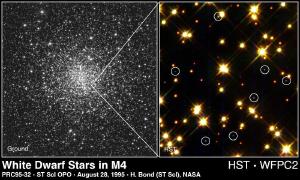Post
Dying Embers
4 August 2013
 H. Bond (ST Scl), NASA
H. Bond (ST Scl), NASADetermining the age of galaxies and globular clusters can be a bit of a challenge. There are several ways you can get a handle on galactic age. One of these is by looking at the ratio of red dwarf stars to larger stars. Red dwarf stars burn very slowly, so their lifetimes can be 100 billion years or more. Given that the universe is only about 14 billion years old, this means that red dwarfs haven’t had time to die off. Larger stars die off faster, so the higher the proportion of red dwarf stars, the older the galaxy should be.
Of course this assumes that all the stars in a galaxy formed around the same time. While this is generally true for star clusters, and to a lesser degree for globular clusters, it isn’t very accurate for galaxies. In galaxies, the largest stars will go supernova, scattering gas and dust that mix with other stellar remnants to collapse into new stellar nurseries. Thus galaxies can produce new generations of stars from old ones. You can still use the red dwarf count to estimate age, but this method isn’t as accurate with galaxies as it is with globular clusters.
Another method is to look at what is known as the metallicity of the stars in a galaxy. In astrophysics, we generally refer to any element other than hydrogen and helium as “metals”. The reason for this is that the amount hydrogen and helium in the universe dwarfs all the other elements combined, so we can put them in the “other” category. The metallicity of a star is a measure of the fraction of metal (in the astrophysics sense) a star has compared to hydrogen and helium.
Metals can only be produced in the cores of stars, so if a star has a high metallicity it must have been formed from the remnants of earlier stars. Stars with low metallicity have formed mainly from the original hydrogen and helium of the universe. So high metallicity stars are younger than low metallicity ones. In this way you can distinguish the initial stars in a galaxy from subsequent generations of stars. This gives you another handle on the age of a galaxy or globular cluster.
There is a third way to determine the age of a galaxy, known as the white dwarf luminosity function. White dwarfs are the remnants of stars like our Sun. If a star is too small to become a supernova when it dies, it will swell to a red giant, casting of some of its outer material before collapsing to a white dwarf. White dwarfs have three important properties that make them very useful in determining the age of a galaxy.
The first is that white dwarfs are generally about the mass of the Sun. There’s a limit to how massive a white dwarf can be (known as the Chandrasekhar limit), of about 1.4 solar masses. If a stellar remnant has more mass than that it will collapse to a neutron star. If it has much less mass than that of the Sun, then it is likely a red dwarf that hasn’t had time to die off yet.
The second is that white dwarfs also have the same general size (about that of Earth). Their size is determined by the pressure of free electrons pushing against each other (a quantum effect known as electron degeneracy pressure). This means their size doesn’t vary with the star’s temperature.
The third is that they form at a temperature of about a million Kelvin. Since white dwarfs have no way to generate heat within themselves, this means they cool over time by radiating light. The amount of radiant heat they emit depends on its temperature and its size.
So white dwarfs have roughly the same temperature and size when they are formed, and they cool via radiation at a rate that depends on their temperature and size. This means you can determine the age of a white dwarf by measuring its temperature. Since hotter white dwarfs are brighter than cooler ones, you can determine their temperature by observing their brightness (or luminosity). The white dwarf luminosity function of a galaxy is the distribution of the luminosities of the white dwarfs in the galaxy. By looking at this function, you can determine not only the age of the oldest white dwarfs, but also the rate at which white dwarfs have formed.
White dwarfs cool rather slowly. As a result most of them are still relatively bright, so they can be observed fairly easily despite their small size. You can see an image of these white dwarfs in a globular cluster in the figure above. Even though they are not as bright as most of the other stars, their high temperature gives them a distinctive bluish hue that makes them easy to distinguish.
White dwarfs are like cosmic cooling embers. In their dying glow is the evidence of the fires of stellar formation, and their glow tells us just how long ago those fires burned.